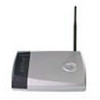Dell TrueMobile 2350 Dell Wireless 2350 Broadband Router User's Guide - Page 68
Internet Protocol IP, Internet Service Provider ISP, IP Address, Link Light, Local Area Network LAN
 |
View all Dell TrueMobile 2350 manuals
Add to My Manuals
Save this manual to your list of manuals |
Page 68 highlights
An Ethernet address is a unique, pre-programmed address, sometimes referred to as a media access control (MAC) address. Each computer on an Ethernet network has its own Ethernet address. This 12-digit hexadecimal address is encoded into the circuitry of the computer's network adapter when it is manufactured. Other devices on the network use this address to identify the computer. This address is not the same as the IP address that is assigned to computers on TCP/IP networks. On these networks, the IP address is associated with the MAC address to enable network communication. Host A host is any device that is connected to the network; for example, a computer, network printer, or router. Each host has a unique name (called "Host Name") or IP address (called "Host IP") for identification on the network. Internet Protocol (IP) IP is the protocol used to send data from one computer to another over the Internet. The IP protocol describes how Internet computers keep track of the IP address of each computer on the network and route packets of data from one IP address to another. Internet Service Provider (ISP) An ISP is a company that provides individuals and other companies access to the Internet and other related services such as website building and virtual hosting. An ISP has the equipment and the telecommunication line access required to have POP on the Internet for the geographic area served. The larger ISPs have their own high-speed leased lines so that they are less dependent on the telecommunication providers and can provide better service to their customers. IP Address An IP address provides unique identification for each computer on the Internet or on a local network. IP addresses are usually expressed as a group of four numbers separated by periods, for example, 169.254.10.2. None of the numbers can be greater than 255. Each Ethernet interface has an IP address. For the Dell Wireless 2350 Broadband Router, there is a LAN Ethernet interface and a WAN Ethernet interface; hence, there is a LAN IP address and a WAN IP address. Link Light A link light is a light on a network device that indicates a good network connection. Hubs typically have a link light for each port; although, they may not be labelled as such, and the lights may show other information. These lights often blink for network activity. Some hubs display different colored lights for 10 Mbps and 100 Mbps. For more information, see the documentation accompanying your product. Local Area Network (LAN) A LAN is a network in one location. The network lets users at that location share files, printers and other services. See WAN. Network Adapter A network adapter is a device expansion card that provides the physical connection between a computer and the network. There are many types of adapters. They include PC cards for laptops (a card that fits into a slot on your computer, like you might install a sound card or modem card) and embedded cards, embedded USB adapters, USB dongle adapters, and USB desktop adapters. Some newer computers have a network adapter already built into the system. PC cards or cards that fit into a slot in the desktop are sometimes referred to as network interface cards, or NICs. Network Address Translation (NAT)















